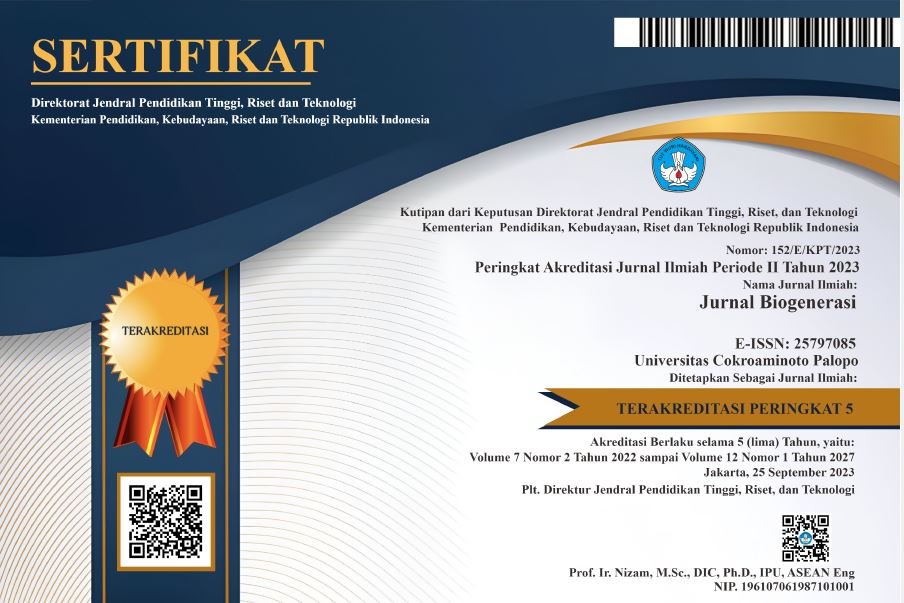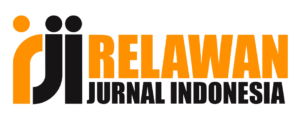EKSPLORASI DAN IDENTIFIKASI JAMUR TRICHODERMA SP DENGAN METODE PENGENCERAN SEBAGAI AGEN HAYATI DI LABORATORIUM AGENS HAYATI UPT PROTEKSI TANAMAN PANGAN DAN HORTIKULTURA JAWA TIMUR
DOI:
https://doi.org/10.30605/biogenerasi.v10i2.5627Keywords:
Trichoderma Fungus, Biological Agent, Food CropsAbstract
This study aims to determine the results of Trichoderma sp fungus exploration in healthy bamboo and chili horticulture land and dense chili and to determine the macroscopic and microscopic characteristics of Trichoderma sp fungus as a biological agent. This type of research is descriptive exploratory with tools and materials, namely Aquades, 70% alcohol, PDA media, potatoes, technical agar, dextrose, chloramphenichol, tomato soil samples, healthy chili soil, dense chili soil, bamboo soil, tissue, methylated spirits, LPG, plastic wrap, cotton, label paper. The tools used are hoes, scoops, rulers, PH meters, rapitest, Laminar air flow, Ose needles, Petri dishes, test tubes, Erlenmeyer flasks, L sticks, Vortex, Plastic, Plastic boxes, Bunsen burners, stoves, sterilization pans, autoclaves, tube racks, tweezers, microscopes, glass objects, cover glasses, scales, trays, 1cc syringes, black cloth. Based on the results of exploration and identification activities, Trichoderma sp fungi were obtained with the dilution method precisely at a dilution level of 10-7. In addition, Trichoderma sp fungi were found in tomato soil. The diversity of fungi in tomato plants depends on environmental conditions. The value of tomato rhizosphere diversity in non-endemic is H'> 3.
Downloads
References
Gusnawaty, H. S., Taufik, M., & Asis, A. (2017). Uji Efektivitas Beberapa Media Untuk Perbanyakan Agens Hayati Trichoderma SP. Jurnal Hama dan Penyakit Tumbuhan Tropika, 17(1), 70-76.
Lehar L. (2012). Pengujian pupuk organik agen hayati (Trichoderma sp) terhadap pertumbuhan kentang (Solanum tuberosum L). Jurnal PenelitianPertanian Terapan, 12(2), 115-124.
Lestari, I., Umboh, S. D., & Pelealu, J. J. (2018). Tingkat Populasi Jamur Tanah akibat Perlakuan Fungisida Mankozeb di Pertanaman Sayur Kubis (Brassica oleracea var. capitata) Kecamatan Modoinding, Kabupaten Minahasa Selatan, Sulawesi Utara (The Population Level of Soil
Magiatuti, E., Soesanto, L., & Manan, A. (2018). Pelatihan teknologi budidaya dan pengelolaan penyakit ramah lingkungan pada tanaman lada. Jurnal Pengabdian Kepada Masyarakat, 8(2), 66-73.
Mukarlina, Khotimah S, & Febrianti L. (2013). Uji antagonis Trichoderma harzianum terhadap Erwinia sp. penyebab penyakit busuk bakteri pada Aloe vera. J. Fitomedika 7(3): 150–154.
Nadhifah YM, Hastuti US, Istamar S. (2016) – Isolasi, karakterisasi, dan identifikasi mikoflora dari rizosfer tanah pertanian tebu (Saccharum officinarum L.) sebagai bahan ajar Kingdom Fungi untuk siswa kelas X SMA. Jurnal Pendidikan, 1 (10), 2023-2030.
Purwantisari S & Hastuti RB. (2009). Uji antagonisme jamur Phytophthora infestans penyebab penyakit busuk daun dan umbi kentang dengan menggunakan Trichoderma sp. isolat lokal. J.Bioma. 11(1): 24–32.
Syahputra, M. H., Anhar, A., & Irdawati, I. (2017). Isolasi Trichoderma spp. dari Beberapa Rizosfer Tanaman Padi Asal Solok (Isolation Trichoderma spp. from Seme Rizosphere Rice Plants Solok). Berkala Ilmiah BidangBiologi, 1(2), 97-105.
Tanzil, A. I., Muhibuddin, A., & Djauhari, S. (2015). Eksplorasi jamur tanah pada rizosfir tomat di lahan endemis dan non endemis Fusarium oxysporum.
Yudha MK, Soesanto L, Mugiastuti E. (2016)– Pemanfaatan empat isolat Trichoderma sp. untuk mengendalikan penyakit akar gada pada tanaman Caisin. Jurnal Kultivasi 15 (3), 143-149.
Downloads
Published
How to Cite
Issue
Section
License
In submitting the manuscript to the journal, the authors certify that:
- They are authorized by their co-authors to enter into these arrangements.
- The work described has not been formally published before, except in the form of an abstract or as part of a published lecture, review, thesis, or overlay journal.
- That it is not under consideration for publication elsewhere,
- That its publication has been approved by all the author(s) and by the responsible authorities – tacitly or explicitly – of the institutes where the work has been carried out.
- They secure the right to reproduce any material that has already been published or copyrighted elsewhere.
- They agree to the following license and copyright agreement.
License and Copyright Agreement
Authors who publish with this journal agree to the following terms:
- Authors retain copyright and grant the journal right of first publication with the work simultaneously licensed under Creative Commons Attribution License (CC BY 4.0) that allows others to share the work with an acknowledgment of the work's authorship and initial publication in this journal.
- Authors are able to enter into separate, additional contractual arrangements for the non-exclusive distribution of the journal's published version of the work (e.g., post it to an institutional repository or publish it in a book), with an acknowledgment of its initial publication in this journal.
- Authors are permitted and encouraged to post their work online (e.g., in institutional repositories or on their website) prior to and during the submission process, as it can lead to productive exchanges, as well as earlier and greater citation of published work.


.png)

